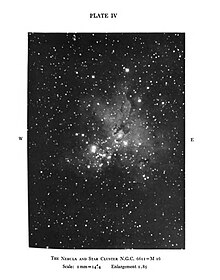John Charles Duncan
John Charles Duncan | |
|---|---|
 As Wellesley College Professor of Astronomy in 1932 | |
| Born | February 8, 1882 |
| Died | September 10, 1967 (aged 85) |
| Alma mater | Indiana University, Bloomington; University of California, Berkeley, California |
| Scientific career | |
| Fields | Astronomy |
| Institutions | University of Arizona Harvard University Radcliffe College Wellesley College |
| Signature | |
 | |
John Charles Duncan (February 8, 1882 – September 10, 1967) was an American astronomer. He is the first to describe the nebular structures now known as the Pillars of Creation.
Life
[edit]Duncan was born on February 8, 1882, in Knightstown, Indiana, to Daniel Davidson and Naomi Duncan (née Jessup).
He graduated from Indiana University and received his Bachelor of Arts there in 1905. In 1905/1906, he received the first Lawrence Fellowship donated by Percival Lowell to students of Indiana University at the Lowell Observatory in Flagstaff, Arizona, and participated in the photographic search for Trans-Neptunian planets. In the summer of 1912 he returned to the Lowell Observatory to help with the search. After receiving his Master of Arts in 1906, he began his doctoral studies at the University of California under the director of the Lick Observatory William Wallace Campbell,[1] and in 1909 defended his dissertation on the Cepheids Y Sagittarii and RT Aurigae.[2]

Duncan was a lecturer at Harvard University from 1909 to 1916, and from 1911 until 1916 also at Radcliffe College, before he was appointed in 1916 the professor and director of the Astronomy Department of Wellesley College and director of the Whitin Observatory. After retiring in 1950, he spent the next twelve years as a visiting professor at the Steward Observatory.[3]

Much of his later work was closely linked to the Mount Wilson Observatory, which he visited for the first time in 1920–21, and where he spent the summers from 1922 to 1949 as a volunteer. There he took numerous photographs of galaxies and nebulae, explored the extent and filaments of the Crab Nebula, and discovered three variable stars in the Triangulum Nebula.[4] For his 1920 photograph of the Eagle Nebula, he provided the first published description of the structures now known as the Pillars of Creation.[5][6] His textbook on astronomy was republished several times, from the first edition in 1926 through the fifth edition in 1955,[7] and an abridged 1947 edition.[8]

Duncan was a Fellow of the Royal Astronomical Society and the American Astronomical Society (as Secretary of the later from 1936 to 1939), as well as a member of the International Astronomical Union, and since 1938 the American Association for the Advancement of Science, the American Academy of Arts and Sciences and numerous other scientific organizations.[9] The asteroid 2753 Duncan, discovered on 18 February 1966 at the Goethe Link Observatory, was named after him.[10]
John Charles Duncan was married to Katharine Armington Bullard since 1906, with whom he had a daughter. He died on September 10, 1967, aged 85, in Chula Vista, California.
Selected works
[edit]- John Charles Duncan (1909). The Orbits of the Cepheid variables Y Sagittarii and RT Aurigae; with a Discussion of the possible Causes of this Type of Stellar Variation. Lick Observatory Bulletin (Thesis). pp.82–94. Bibcode:1909LicOB...5...82D.
- Stetson, Harlan True; Duncan, John Charles (1925). A Manual of Laboratory Astronomy for use in Introductory Courses (3 ed.). Boston: Eastern Science Supply Co. OCLC 950564298.
- John Charles Duncan (1927), Astronomy: A Text Book, London & New York: Harper & Brothers
- John Charles Duncan (1942). Essentials of Astronomy. New York: Harper & Brothers.
References
[edit]- ^ Dieke, Sally H. (1971). "Duncan, John Charles". Dictionary of Scientific Biography. Dictionary of Scientific Biography. Vol. 4. New York: Charles Scribner’s Sons. p.249. Retrieved 2019-09-16.
- ^ John Charles Duncan (1909). The Orbits of the Cepheid variables Y Sagittarii and RT Aurigae; with a Discussion of the possible Causes of this Type of Stellar Variation. Lick Observatory Bulletin (Thesis). pp.82–94. Bibcode:1909LicOB...5...82D.
- ^ "Duncan, John Charles", National Cyclopedia of American Biography, vol. 4, Clifton, New Jersey: James T. White and Co., pp.88–89, 1973
- ^ Rudi Paul Lindner (2007), Thomas Hockey (ed.), "Duncan, John Charles", Biographical Encyclopedia of Astronomers, vol. I (A–L), New York: Springer Science+Business Media, pp. 315–316, ISBN 978-0-387-31022-0
- ^ Duncan, J. C. (1920). "Bright nebulae and star clusters in Sagittarius and Scutum photographed with the 60-inch reflector". The Astrophysical Journal. 51: 4. Bibcode:1920ApJ....51....4D. doi:10.1086/142519.
- ^ Oliveira, Joana M. (2008). Star Formation in the Eagle Nebula. arXiv:0809.3735. Bibcode:2008hsf2.book..599O.
- ^ John Charles Duncan (1927), Astronomy: A Text Book, London & New York: Harper & Brothers
- ^ John Charles Duncan (1942). Essentials of Astronomy. New York: Harper & Brothers.
- ^ Rudi Paul Lindner (2014), Thomas Hockey (ed.), "Duncan, John Charles", Biographical Encyclopedia of Astronomers (Second ed.), New York: Springer Science+Business Media, pp. 619–620, Bibcode:2014bea..bookR.619L, doi:10.1007/978-1-4419-9917-7_387, ISBN 978-1-4419-9916-0
- ^ Lutz D. Schmadel (1997), Dictionary of Minor Planet Names, vol. I (Third Revised and Enlarged ed.), Berlin, Heidelberg: Springer-Verlag, p. 356, ISBN 978-3-662-06617-1
External links
[edit]- 1882 births
- 1967 deaths
- University of Arizona faculty
- 20th-century American astronomers
- People from Knightstown, Indiana
- Fellows of the American Association for the Advancement of Science
- Fellows of the Royal Astronomical Society
- Fellows of the American Academy of Arts and Sciences
- Harvard University alumni
- University of California alumni
- Scientists from Indiana
- Burials at Crown Hill Cemetery
- Whitin Observatory
